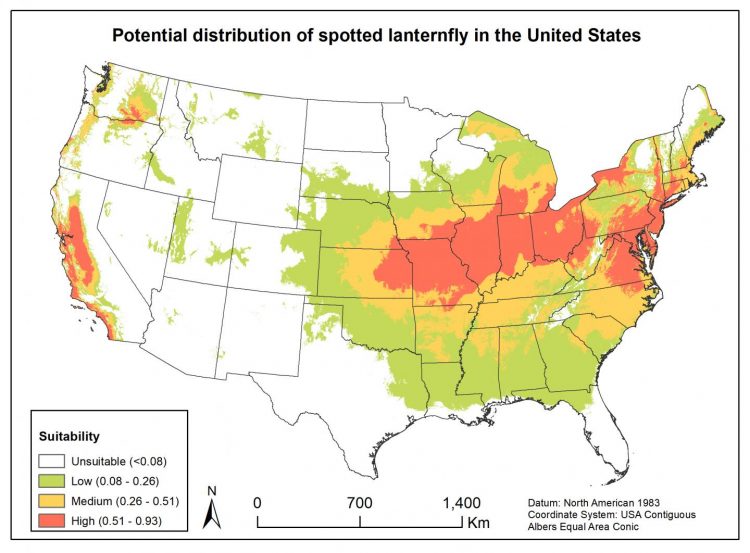
Credit: ARS-USDA
WAPATO, WASHINGTON, October 3, 2019–Maps identifying the areas suitable for establishment of the spotted lanternfly (SLF) in the United States and other countries have been published in the Journal of Economic Entomology by Agricultural Research Service scientists.
The SLF, originally from China, has spread to Korea and Japan, and has been found most recently in the United States in Pennsylvania, New Jersey, Virginia and Delaware. These insects are pests of many agricultural crops including almonds, apples, blueberries, cherries, peaches, grapes and hops as well as hardwoods such as oak, walnut and poplar, among others. USDA and state partners have been working to contain SLF populations since 2014.
There is the potential for far reaching economic damage if the SLF becomes widely established in the United States.
Within the United States, SLF could eventually become established in most of New England and the mid-Atlantic states, the central United States, and Pacific coastal states, explained ecologist Tewodros Wakie with the ARS Temperate Tree Fruit and Vegetable Research Unit in Wapato, Washington, who led the project.
“Earlier attempts to predict the spread of the spotted lanternfly using a less sophisticated model had indicated a potential for the pest to become established in warmer areas such as southeastern Florida and in tropical countries,” Wakie said. “But we made use of a more complex model called MAXENT that depends on a wider number of environmental factors including temperature, elevation and rainfall as well as the current known locations of the species.
MAXENT has proven to be much more accurate at predicting where species are likely to spread compared to 16 other methods on 266 species.
“There are numerous examples where new populations of species were discovered following MAXENT predictions. Our lab group used MAXENT to predict the potential distribution of oriental fruit moth, and apple maggot, and predictions have been more accurate than anything previously,” said Wakie.
Eleven European countries and large parts of the Northeast United States and the Pacific Northwest were found to be prime habitat for SLF establishment in place of tropical locales with MAXENT.
The most important factor in predicting SLF establishment is the mean temperature of the driest quarter of the year; it cannot be too hot or too cold, about 0 degrees C plus or minus 7 degrees C (a temperature range between 19 and 45 degrees F), Wakie explained.
Another important factor in predicting SLF’s possible range is the presence of the tree of heaven–an invasive plant that also originated from China. Although not the only host plant for SLF, it is a highly important host plant for the insect. Studies are underway to identify additional host plants and to find the right biocontrol system.
Results from this study can be used to guide SLF surveys and prioritize management interventions for this pest, Wakie added.
###
The Agricultural Research Service is the U.S. Department of Agriculture’s chief scientific in-house research agency. Daily, ARS focuses on solutions to agricultural problems affecting America. Each dollar invested in agricultural research results in $20 of economic impact.
Media Contact
Kim Kaplan
[email protected]





